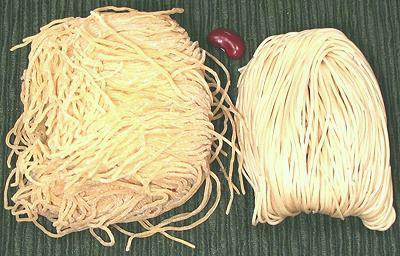 [Artificial Noodles, Asian Noodles]
[Artificial Noodles, Asian Noodles]
This has traditionally been the most common form of Asian noodles in North America, usually sold as small skeins of dry noodles. Today they can also be found "fresh" in the refrigerated section of any market serving a substantial Asian community.
Once labeled "Imitation Noodles", because they didn't fit the government's formula for noodles, today they are labeled "Egg Noodles" or "Artificial Egg Noodles" (the ones with yellow dye and no egg) or "Asian Noodles".
The photo skein of fresh noodles (left), made in California, was 3-7/8 ounces of noodles 0.045 inch diameter. The dried (right), made in Hong Kong, was 1-1/2 ounces of noodles 0.040 inch diameter. The weight of skeins is not standard and may vary even in the same package. The fresh came in a package of two 3-7/8 ounce skeins and two 6-1/4 ounce skeins.
More on Asian Noodles.
I prefer the fresh noodles when possible, but the dried keep forever so may be all I have on hand. I always try to buy versions with real egg in them rather than just yellow dye #5 and #6.
For the most common uses, particularly stir fries, noodles can be difficult to handle and will tend to lump up rather than blend with other ingredients. Keep in mind you aren't a Southeast Asian street vendor who practices 8 hours a day 365 days a year so take all measures to make the job easier.
Aside from your wok shovel you want a good, easy to use pair of tongs. Once you get the noodles in the pan the wok shovel becomes nearly useless, but tongs will help you break up lumps of noodles and get the rest of the ingredients spread through.
Taking a couple knife strokes through the pile of noodles before adding, to the recipe, so they are about 5 inches long, will also help make them manageable, though Asians are resistant to cutting noodles.
Many recipes say to add noodles (soaked or fresh) without pre-cooking. I find this a very bad policy. It makes it impossible to accurately judge the amount of liquid you need in the recipe, and you can't accurately judge what weight of noodles you'll end up with. If it's too much, well, it's too late now. Also texture and flavor come out better pre-cooked.
The biggest advantage of pre-cooking, though, is you can have the noodles in the pan the minimum amount of time needed to mix and warm - then get them out before they all stick to the pan and break up into mush.
These would more accurately be described as "semi-dry". The photo specimen skein was made in California from enriched flour, fresh eggs, water, salt, potassium sorbate and artificial color FD&C Yellow #5.
Buying & Storage: Find them in the refrigerated section of markets serving an Asian community. Refrigerated in their unopened package they will keep a couple weeks to a month but will eventually succumb to mold. Once the package is opened, even if resealed, they'll become moldy within a week.
Cooking: Bring salted water to a boil as for any other pasta. Cook for 4 to 5 minutes, drain. Since this will normally be done a little ahead you need to keep the noodles from sticking together. Chinese cookbooks usually say to rinse them with cold water but I prefer to tumble them with just a bit of oil - and reduce the oil in the recipe by the same amount.
Yield A 4 ounce skein will cook to 11.4 ounces (285%).
The photo specimen skein was made in Hong Kong from flour, cornstarch, egg, lye water and FD&C Yellow #5.
Cooking: Soak the noodles in warm (not hot) water for about 20 minutes or until softened through. Drain. Bring salted water to a boil as for any other pasta. Cook for 3 minutes, drain. Since this will normally be done a little ahead you need to keep the noodles from sticking together. Chinese cookbooks usually say to rinse them with cold water but I prefer to tumble them with just a bit of oil - and reduce the oil in the recipe by the same amount.
Yield A 2 ounce skein, soaked and cooked, will weigh about 7.7 ounces (385%)
pa_chthinz 090803 - www.clovegarden.com